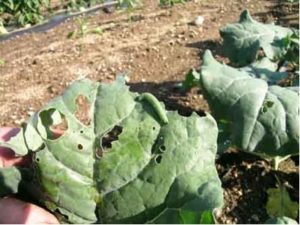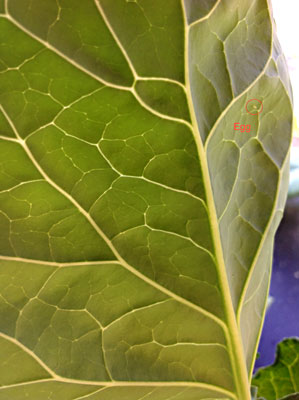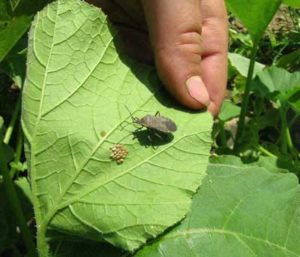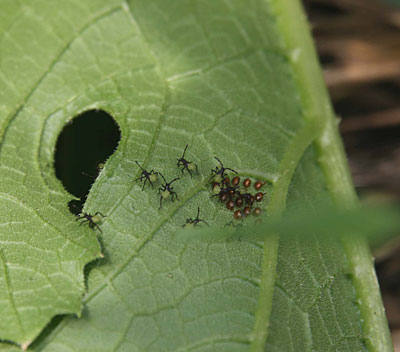The growing season so far has been fairly uneventful in that there are no major outbreaks of diseases or pests. Still, I have seen some pests in large numbers and there are some problems looming on the horizon.
In this issue:
Imported cabbage worms and other caterpillars in Brassica crops and lettuce
Late blight
Asiatic Garden Beetle
Squash bug
Squash Vine Borer
 |
| Imported cabbage worm |
 |
| Cabbage worm egg, circled in red. |
  |
| Squash bug adult and eggs |
 |
| Squash bug hatch |
IMPORTED CABBAGE WORM
The white butterfly with the dark marks on its wing that are flying in large numbers around the vegetables is a troubling site. They are very numerous this year. Becky can find the eggs they lay, and the tiny caterpillars that hatch. I only notice them after I see the holes and chunks chewed out of the leaves. The imported cabbage worm is the most common of the three different caterpillars often found feeding on cabbage, broccoli, Brussels sprouts, kale, etc. By the way, it also feeds on lettuce. The pest overwinters as a pupa in crop debris and is a common pest every year.
There are two other caterpillars often seen feeding on brassica crops; the diamondback moth and the cabbage looper. The looper does not overwinter in the north, and any overwintering of the diamondback is spotty at best. These pests are carried up here with storms. Hence problems from these pests vary from year to year.
All three pests produce multiple generations each growing season. It is important to destroy the crop debris after harvest so as not to harbor future generations that will move onto your later plantings. Controlling cruciferous weeds will help. Row covers will work however these crops do not do well in heat so there could be problems.
Bt gives good control of all three caterpillars. Dipel is a common brand. But, as usual, if you are a certified grower be sure that the formulation you use is approved for organic production. Spinosad works even better, but is more expensive. Be sure to scout the crops and spray only when the pest is present. Bt must be eaten to work and since it degrades quickly in sunlight it should be sprayed when the pest is actively feeding. There is no protective activity.
Top
LATE BLIGHT
There are no reports of late blight in northern New England. There have been a few reports from New York and Pennsylvania so it is worth keeping our eyes and ears open. If you want to refresh your memory of what late blight looks like and its biology, see https://www.longislandhort.cornell.edu/vegpath/photos/lateblight_tomato.htm
Top
ASIATIC GARDEN BEETLE
I am getting my first reports of Asiatic garden beetle. I have heard that they are flying into some fruit trees as well as feeding on herbs and vegetable crops. The Asiatic Garden Beetle is a native of Japan and China where it is not an important pest. The pest overwinters in the soil as a grub feeding on the roots in sod ground and weedy gardens. Some farmers are reporting problem with the grubs in their crop fields (strawberries especially). The larvae (grubs) pupate early in the spring and the resulting adults emerge in June and start feeding on all sorts of garden vegetables. The adults are cinnamon-to reddish brown, rounded beetles. They eat big and irregular holes in the leaves and blossoms. You have to look hard to find them because they feed at night and burrow into the soil for the day. If you see chewed leaves and no pest, then go out at night with a flashlight and see who is there. It will probably be cutworms, or the Asiatic garden beetle. If you have the problem, fall clean up with tilling the garden is important. Pesticides offer some control but often they are very numerous and seem to return from nowhere. Spinosad (Entrust and Monterey Garden Spray) have been reported to work well.
For information about the other scarab beetles (including the Japanese beetle and oriental beetle) see the August 9, 2010 Pest Report.
Top
SQUASH BUG
I have not seen squash bugs yet, but they are coming soon. Squash bugs are serious pests throughout North America. When populations are high the entire crop can be destroyed. Damage and survival are low on watermelon, very low on cucumber and muskmelon, and highest on squash and pumpkin. Both adults and nymphs feed by inserting their mouth part and sucking juices from plant tissue. Toxic saliva injected during feeding causes foliage to wilt, then turn black and die. The severity of this damage is directly related to density of squash bugs on each plant. Often I get calls from growers who believe they have a disease because the leaves are browning up and dying. Later in the season, squash bugs may feed on the fruit, causing them to collapse or become unmarketable.
Adult squash bugs are a half to three quarters of an inch long, flattened and grayish-brown. They hibernate in crop debris in and around the garden for the winter and emerge in the early summer to feed a bit but mostly interested in mating and laying eggs. Eggs are laid in clusters usually on the underside of leaves. They are orange when first laid, but turn bronze-colored before they hatch. The wingless nymphs are similar in appearance to adults. They are whitish when small, with a brown head, then turn gray when larger with black legs. There is one generation per year in the Northeast.
The adults that arise from these nymphs will begin looking for a winter home in the fall. Infestation is delayed by row covers. If possible, rotate cucurbit crops between fields as far apart as possible. Black plastic, straw mulch, and reduced tillage systems encourage higher populations, probably by providing good hiding places. Remove plastic and straw mulch at the end of the season. Squash bug numbers are reduced by clean cultivation in the fall. Keep headlands mowed and free of trash to reduce overwintering sites.
Now is the time to scout undersides of leaves for squash bug adults and eggs. In small plantings you can reduce the population greatly if you crush the eggs you find. You may not want to crush the bugs as they stink when you do. Squash bugs are unusually difficult to control with insecticides. Time squash bug sprays to kill young nymphs just after they hatch, because this stage is the easiest to control. I suggest that you mark some egg clusters when you find them with a piece of ribbon and then watch them over a few days to note when they hatch so you catch the nymphs when they are small. Squash bug adults and large nymphs are very difficult to control, especially when the canopy becomes dense. Treat very, very early in the morning or very late in the day when the flowers are closed to reduce risk to bees. Pyrethrum and neem products have proved effective on the young nymphs. Some recent trials of mixtures of pyrethrum and neem have shown good control. There is a new material available called Azera, which is a mixture of pyrethrum and neem. Trials with this material for squash bug are happening this year at Cornell and I look forward to the results.
(Source material for this came from the New England Vegetable Management Guide, the UMass Vegetable Newsletter, and the Resource Guide to Organic Insect and Disease Management)
Top
SQUASH VINE BORER
Squash vine borers (SVB) are showing up in traps in N.H., and I am sure that southern Maine is next. Many vine crops are beginning to bloom, and the row covers are being taken off to allow the bees access. That means the borer now has access too. Care should be taken during bloom to avoid using insecticides when the bees are active.
Squash vine borer moths are day-flying. They have a 1.0 to 1.5 inch wingspan and bright orange markings. In flight, they look like wasps. There is one generation each year. Adults emerge in late June/early July. The moths fly slowly in zig-zags around plants and lay eggs singly on stems; eggs are usually found on the main stem near the base, but are also found on leafstalks or on the undersides of leaves. Upon hatching, larvae bore into stems (where they are protected from insecticides). Thick-stemmed squashes are preferred. Unless you use traps or scout fields for evidence of eggs or larvae, the first sign of squash vine borer infestation is often wilting vines in July and August. By that time, it is too late to do anything.
Growers should scout their pumpkin and squash fields weekly for squash vine borer from late June through early August. Examine the base of vines for eggs. The squash vine borer can be killed with an insecticide and the recommendation would be spinosad (Entrust, Monterey Garden Spray), or the Bt aizaiwi strain (Agree WG). Appropriate timing is crucial. The insecticide is most effective when applied to young larvae before they bore into the stem. Once they are in the stem the insecticide will be useless. If you see the moths flying, or hear reports from local Extension about SVB flights, or find eggs, then two insecticide sprays, ideally applied to the base of the plants and timed five to seven days apart, will control newly hatching larvae before they are able to bore into the stem.
Again, the timing is crucial and there is no point in spraying before you find evidence, or after the larvae bore into the stem. If you are a small scale grower, and evidence of larval feeding (sawdust-like frass near entrance holes) is found, then split open the stem to confirm the presence of larvae, which, by the way, may suggest more eggs are being laid so scout. Borers can be removed from vines if detected before much damage is done. Slit the stem longitudinally, remove the borer, then cover the wounded stem with moist soil above the point of injury to promote additional root formation. Some growers monitor for the moths themselves using Scentry Heliothis pheromone traps from early June through early August. If more than 5 moths per week are captured, then they make 2 to 4 weekly applications of pesticides. Timing is very important, so this is not recommended for the casual gardener.
(Source material for this from the New England Vegetable Management Guide; UMass Vegetable Newsletter, The Resource Guide to Organic Insect and Disease Management, and the SVB Report from UNH Extension’s George Hamilton)
